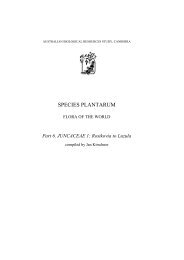Introduction - Species Plantarum Programme
Introduction - Species Plantarum Programme
Introduction - Species Plantarum Programme
Create successful ePaper yourself
Turn your PDF publications into a flip-book with our unique Google optimized e-Paper software.
Bibliography of illustrations<br />
24<br />
SPECIES PLANTARUM — FLORA OF THE WORLD (1999)<br />
Following the synonyms there may be a paragraph citing one to three published illustrations<br />
of the species. These should be good, representative illustrations in readily available works.<br />
Photographs may be cited provided they show detail of the flowers or fruit. Where there are<br />
infraspecific taxa the illustrations should be cited under the appropriate taxon. In the<br />
citations, authors' names are given in full but the titles of articles are omitted. Both page<br />
number and figure number (if present) should be given. If the taxon name in the caption to<br />
the illustration differs from the accepted name in the Flora, then it is added in the form 'as<br />
....' after the reference.<br />
Brief annotations to the references may be used sparingly where it is necessary, e.g. where<br />
illustrations are photographs of herbarium specimens not line drawings.<br />
Illustrations: J.M.Black, Fl. S. Austral. 2nd edn 755, fig. 1081, as D. metel L.; W.T.Parsons, Noxious Weeds<br />
Victoria, 256, fig. 238A(3) (1973); B.J.Grieve & W.E.Blackall, How to Know W. Austral. Wildfl. 4: 603<br />
(1975).<br />
Bibliography of maps<br />
Extract from Fl. Australia 29: 193 (1982)<br />
Following the paragraph on illustrations, another paragraph in the same format may be<br />
added, listing 1 to 3 references to distribution maps of the species.<br />
<strong>Species</strong> descriptions<br />
Descriptions of species are limited to an average of 100 words, maximum 150 words (see<br />
p. 11, Word count). It is strongly recommended that they be kept well within this limit. They<br />
should be readily understandable in relation to the generic description. <strong>Species</strong> descriptions<br />
within any one genus or subdivision of a genus should be directly comparable as far as<br />
possible. If, for a particular species, an organ described for all other species has not been<br />
seen, this should be stated.<br />
Characters common to all species should be covered in the generic description. This is<br />
especially useful when there is difficulty in keeping to the 100-word limit.<br />
<strong>Species</strong> descriptions usually contain a number of measurements. These are always given in<br />
metric units, – µm, mm, cm or m. As a rough guide, use cm for sizes over 3 cm, but<br />
consideration should be given to the level of precision intended. For example 1–2 cm is less<br />
precise than 10–20 mm. It is important to be consistent within descriptions and in particular<br />
for individual organs. If nine of ten species in a genus have leaves less than 3 cm long but<br />
the other has leaves 9 cm long then use the same unit of measurement (mm in this case) for<br />
them all. For long, narrow organs it is acceptable to use different units for length and width,<br />
e.g. leaves 2–4 m long, 2–3 cm wide. The form 3–4 cm × 1–2 cm should be avoided in most<br />
circumstances, but may be acceptable where there is no ambiguity in deciding which<br />
measurement refers to length and which to breadth. An example might be 'Fruit usually 3–5<br />
mm long, 1–2 mm wide (rarely up to 7 × 4 mm)'. If this form of expression is used, then the<br />
multiplication sign (×) rather than the letter (x) should be used.<br />
Description of leaves can be particularly complex. The following general order and<br />
punctuation should be followed (although not all points will be needed in all taxa):<br />
Arrangement, deciduous/nondeciduous; overall shape (compound leaves), overall size<br />
(compound leaves), simple/compound type, petiolate/sessile; stipules; petiole shape, petiole<br />
size; lamina shape, lamina size, base, margins, tip, midrib, secondary venation, indumentum;<br />
leaflet characteristics in same order as lamina. In very simple leaf descriptions, to avoid<br />
ambiguity, the lengths of the lamina and petiole should be described separately.












